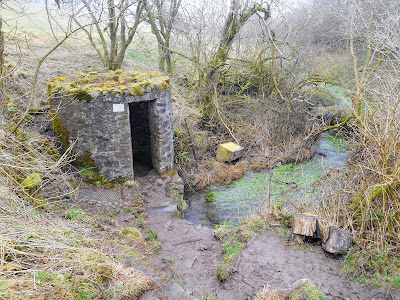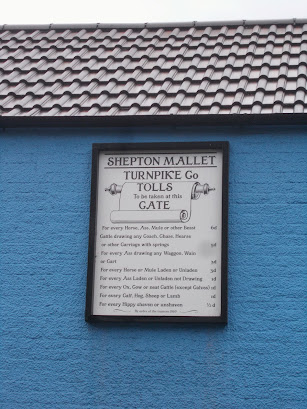Turnpikes trusts erected gates across their roads at strategic locations to collect tolls from the people who used them. Early turnpikes had wooden gates but those built in the 19th century often had gates made of wrought iron. The gates were often at points where it was least likely that horse riders or horse drawn vehicles could avoid paying the toll e.g. bridges and crossroads. They were usually located outside urban areas to avoid charging local businesses.
The word turnpike was originally a military term for "a spiked barrier fixed in or across a road or passage, as a defence against sudden attack, especially of men on horseback." (Oxford English Dictionary). The bars erected on toll roads resembled these barriers and so they were referred to as turnpikes from the late 17th century.
In some cases existing cottages were adapted to house toll collectors (or pikemen as they were sometimes known) and their families. Sometimes temporary shelters were built for the toll collectors. Later on most toll houses were purpose built. Early toll houses were built in the same style as local cottages in the area but by the 19th century a distinctive style evolved. Many toll houses resembled the lodges built at the entrance to large estates and those built in the 1820s had polygonal fronts, which gave the toll collectors good views up and down the roads. Toll houses were usually built close to the road and many of them had porches, which jutted out into the road. On major roads grander toll houses were built e.g. with castellations on them to impress wealthy travellers. The isolated location of most toll houses meant that they were vulnerable to attack by thieves and highwaymen. Therefore the windows often had shutters and/or bars on them and the houses also had built-in safes. Toll houses were often built to a higher standard that most of the local vernacular cottages, in order to attract honest and reliable toll collectors.
In the early 19th century there were two different methods of road construction in general use, which had been developed by Thomas Telford (1757-1834) and John Loudon McAdam (1756-1836). Telford's method with 9" long stones packed together on end, with smaller stones rammed into the top and a layer of small stones on the top, was very effective, but also expensive.
McAdam's method was cheaper: stone was broken into pieces weighing less than 6 ounces. This was then spread in layers to a depth of 10". This method re-used material recovered from earlier surfaces. The surface was not rolled - it was gradually compacted by passing traffic.
John Loudon McAdam became the General Surveyor to the Bristol Turnpike Trust in December 1815. He worked for the Bristol Trust with his son, who was also called John Loudon McAdam, until his death in 1836. In 1826 he also became General Surveyor for the Bath Trust. He worked for the Bath Trust with his grandson William until 1836.
The turnpike road network reached its greatest extent in the 1830s when there were over 20,000 miles of roads controlled by over 1,000 trusts in England and Wales. Traffic on the turnpike roads declined from the 1840s as the railway network developed.
Most turnpike trusts were wound up in the 1870s and the toll houses were sold off. Some became commercial buildings such as pubs and post offices but most became residential dwellings. The last turnpike trust to be wound up was one on Anglesey in 1895.
Responsibility for roads was taken over by Highway Districts from 1862. Highway Districts were abolished in 1894 and their duties and powers passed to Rural District Councils. Responsibility for main roads passed to the newly formed County Councils in 1889.
Roads continued to be built and maintained using the Telford and McAdam methods until the early 20th century. Main roads in Somerset were surface dressed with tar from 1908, but it wasn't until the 1920s that they were constructed using several inches of stone, which had been pre-coated in tar or bitumen.
Toll House, Nether Stowey
Toll House, Snowdon Hill, A30, Chard
Horsington Toll House
Horsington Toll Board
Stanton Drew Toll House
Worthy Toll Road Toll House, Porlock Weir - still in use as a toll house
Toll House, Glaston Road, Street
You can see where the original doorway facing the road has been blocked up at some point.
Toll House, Glaston Road, Street
Toll House at Shipham
Red Post Toll House on the A367 at Peasedown St John
This house on Silver Street in Taunton was probably once a toll house
Exebridge Toll House on A396 at the Devon/Somerset border
Toll Cottage, Tower Hill, A358, Williton
Sidcot Gate Toll House on the A38 at Sidcot
Blue plaque on the Sidcot Gate Toll House
Old Down Toll House
This was built in 1835 and is located on the B3139 (Lynch Hill), opposite the junction with Coalpit Lane.
Hartlake Turnpike plaque at the junction of the A39 with Chasey's Drove, to the north of Glastonbury. This was part of the Wells Turnpike Trust.
Terminus stone on the Brendon Hills at Elworthy, marking the western boundary of the Taunton Turnpike Trust
The Taunton Turnpike Trust was in operation from 1752 until 1875.
Part of the toll board from Misterton Gate
This is now on display in the Museum of Somerset in Taunton.
East Cranmore Toll House on the A361
Charlton Toll House on the A361 at Shepton Mallet
Toll Cottage, on the corner of Ford Road (B3188) and Taunton Road (B3227) in Wiveliscombe
Toll house, 48 Chilkwell Street, Glastonbury
Modern toll board on the toll house, 48 Chilkwell Street, Glastonbury
Toll house at Horton Cross near Ilminster
Turnpike House, Westhay
This toll house was on the Wedmore Turnpike Trust's road across the Somerset levels to Rowberrow. It is on the corner of Main Road (B3151) and Westhay Moor Drove. The blank wall facing the road is where the original doorway would have been located.
Further Reading:
The Toll-houses of Somerset by Jane Dowding and Patrick Taylor. Published by Polystar Press, 2013
Somerset Roads: The Legacy of the Turnpikes, Phase 1 Western Somerset by J.B. Bentley and B.J. Murless. Published by Somerset Industrial Archaeological Society, 1985


































